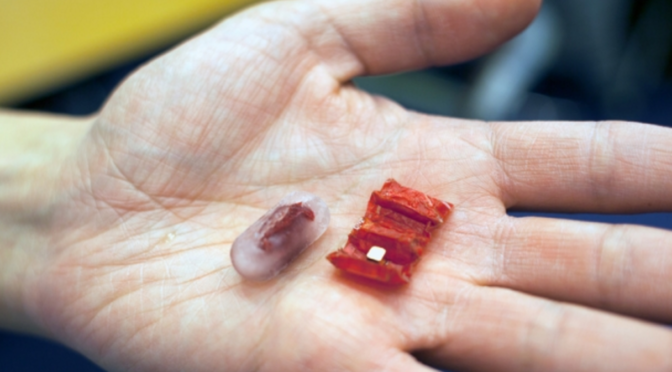Imagine if you could swallow a robot which would come to life once in your stomach and perform basic medical procedures, fixing you from the inside out? It sounds like something from any one of hundreds of sci-fi books or movies, but now researchers at MIT, the University of Sheffield, and the Tokyo Institute of Technology have come together and built a robot that can do just that.
Miniature Robots
Named the ‘origami robot’ because of the way it unfolds inside patients, this new piece of technology could revolutionize the future of medical care around the world. Encased in an ice capsule, the robot can be swallowed and will spring to life once the ice melts away, performing any duties inside the patients, before being passed through the digestive system.
The first challenge the researchers faced was making a robot that was actually swallowable. The robot needed to be designed in such a way that it could be adequately compressed to fit inside a pill, but with enough force to allow it to spring out and fully unfold to perform its duties.
The researchers settled on a rectangular robot with accordion folds and pinched corners which could act as points of traction as it moves through the human body.
Materials
Continuing the challenge of making a robot that could be safely swallowed, the scientists had to decide which material to use to build it. It had to be biocompatible, as patients would essentially be eating it, as well as being degradable, without being dissolved by the stomach’s acid.
They had tested around twelve different possible materials before they found their answer, surprisingly, at a Chinatown market – settling on a type of dried pig intestine often used in sausage casings.
Movement
The robot can maneuver through the body using two methods. The primary way it moves is known as “stick-slip” – the robot’s appendages grip onto surfaces using friction, but will slip free again when its body changes the weight distribution, allowing it to move forwards. However, some of the robot’s life is spent in the stomach, so it is also able to move through liquid using propulsion.
Currently, each robot is built with a magnet attached to it, so it can be controlled by magnetic fields outside the body. This primarily allows scientists to rotate the robot, directing it towards the areas in which it is most needed for it to propel itself in the right direction. The team has plans to implement sensors in the robots in the future which would mean they could control themselves and carry out their jobs unassisted.
Function
The robot can deliver medication to specific locations and even patch wounds. However, one of the most compelling applications for the robots would be in their ability to remove foreign objects from the body that could cause potential damage if they remain inside a person for too long once swallowed.
Every year, there are 3,500 reports of American citizens swallowing button batteries (the kind you get in watches). Often, these will just pass through the body normally, however, if they come into contact with body tissue for an extended amount of time, they can become embedded and begin to burn the individual causing severe and prolonged damage.
The origami robots’ magnets used to aid their movement, have a secondary function here, ‘picking up’ the swallowed battery, and safely moving it through the body – removing the threat without the need for surgery.
The Future of Medicine?
Though these robots are still in development, the fact that they have been able to perform these tasks under experimental conditions with great success could be a sign that we may well be seeing robots on our prescriptions on future visits to the doctor’s office.
Sources:

